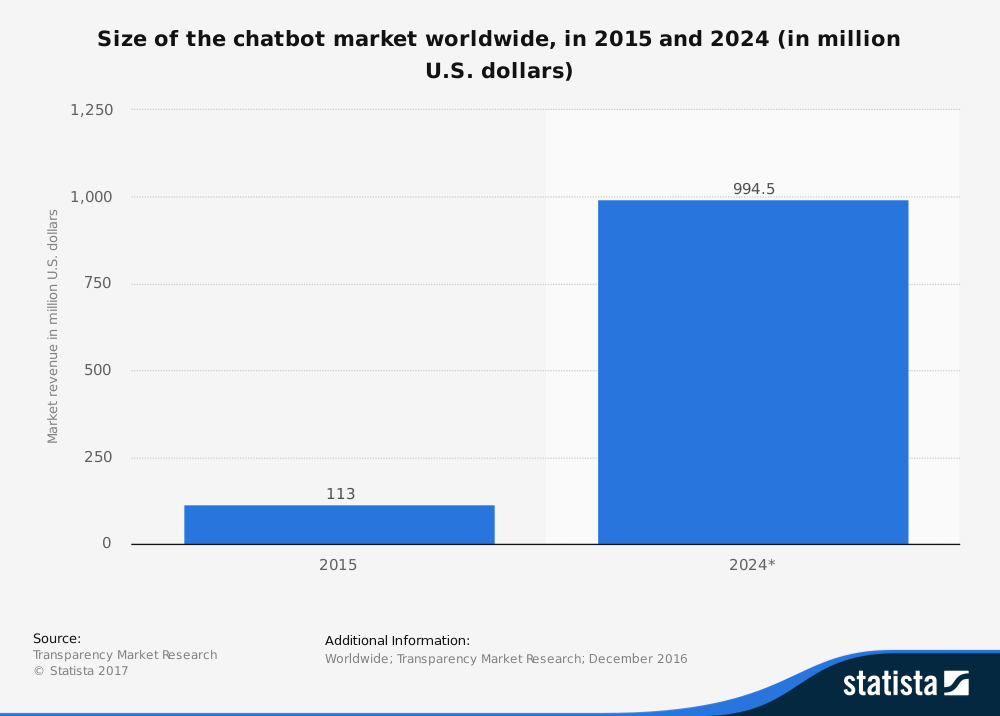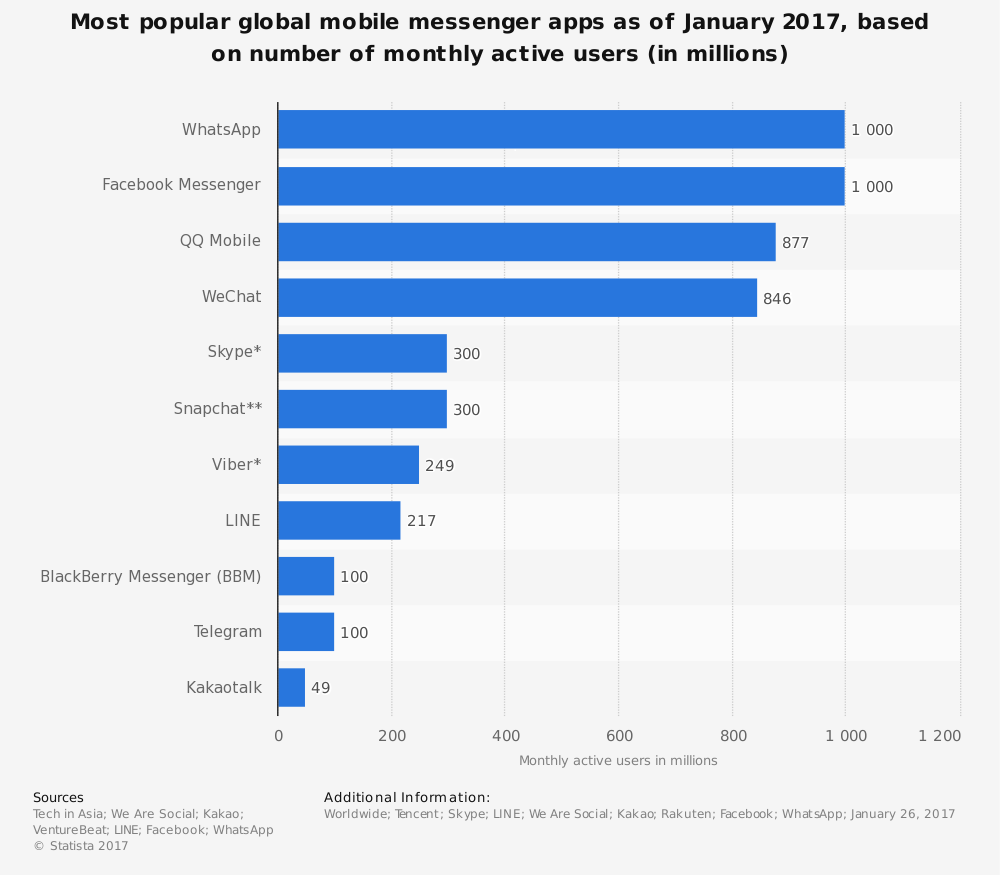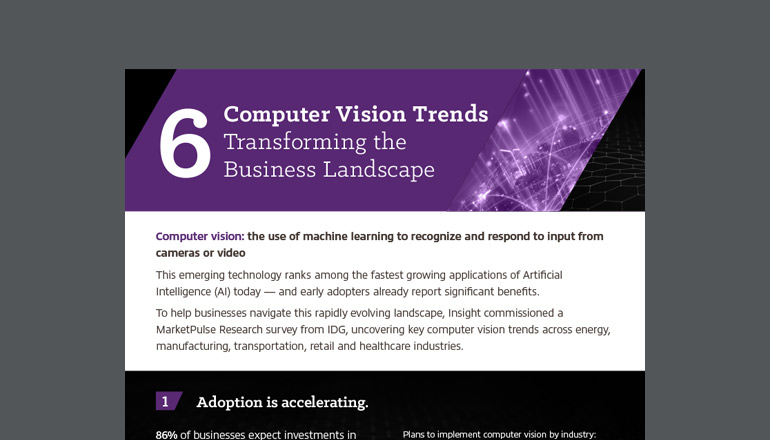Article 5 Undisputable Reasons to Invest in Chatbot Technology
As thousands of chatbots were deployed in 2017, crossing the chasm from idea to reality, tech industry pundits took to the internet to dub 2017 the year of the chatbot. It was the year chatbot technology gained marked attention as masses of the virtual assistants rose to existence.
By Claudia Hrynyshyn / 15 Feb 2018 / Topics: Artificial Intelligence (AI)

But this flock of virtual agents only represented the first generation of the true business bot — the one that will become the norm, not the exception, when it comes to customer service and brand advocacy, more sentient and smarter than ever.
Data from Transparency Market Research forecasts the chatbot market will exceed $900 million by 2024, as shown in Figure 1. And all of the benefits we’ve been promised over the years are becoming clearer as chatbot use cases expand.

Here are five reasons why investing in chatbot technology can help your organisation adapt to a steady (but certain) shift to a smarter way of doing business:
1. Chatbots beat business apps in customer engagement.
The first definition of customer engagement emerged as early as 2006. So if you’re not thinking about new ways to drive customer engagement, you’re more than a decade behind. Since then, customer engagement has taken on dozens of definitions, but most revolve around building ongoing and loyal customer relationships.
And today, 69% of chief information officers and chief technology officers say developing strong technology to create differentiating customer experiences is a pain point for the organisation, according to the “2018 Insight Intelligent Technology Pulse Survey.”
Although business apps can drive continuous customer-to-business contact, retention rates for chatbots are now trending higher. A business chatbot study from Mindbowser revealed a 40–60% user retention rate after a month of bot usage, compared to a 20–40% retention rate from business apps.
Interaction is the differentiator here: On business apps, users get their questions answered through autonomous searching. With a bot, customers get the same information by having a conversation in real time. This what-you-want, when-you-want-it type of interaction feels personal and attentive.

But the next wave of customer engagement will increasingly center on being present where users regularly engage. Research shows a combined user base of more than 1 billion monthly users on messaging platforms such as Facebook Messenger and WhatsApp as of January 2017, as shown in Figure 2.
Jeff Dodge, director of Digital Innovation services at Insight, stresses the importance of this coming wave: “The next paradigm of engagement is instant and infinitely scalable. The convergence of machine learning, natural language processing and the mass adoption of modern social platforms makes this possible. If you aren’t already executing at this level, you are already behind your competition.”
As digital platforms continue to consolidate — making a slew of tasks achievable without the need to open extra apps — businesses will be forced to go where their customers are going.
2. Chatbots reduce costs.
With the potential to automate up to 30% of customer support services, chatbot technology is predicted to cut costs by more than $8 billion per year by 2022, as cited by CNBC. Although building a chatbot can range anywhere from $30,000 to $150,000, depending on the intricacy of the bot’s identity, the long-term savings are proving to be hard to ignore.
How long is long-term, exactly? Only one year, according to the businesses that have invested.
Public transportation company Amtrak launched its virtual assistant, Julie (pictured in Figure 3), who saved the company a whopping $1 million in customer service expenses in a single year. Amtrak also reported an 800% return on investment after launch.

Insurance company Allstate also found its chatbot investment worthwhile. Its bot, the Allstate Business Insurance expert (ABIe) — which helps 12,000 agents answer questions from customers — paid for itself by the end of its first year, according to Allstate.
And Charter, the U.S.’s fourth-largest cable operator, launched Alme, a support chatbot that led to a 44% cost reduction after a year, as well as 500% return on investment in the first six months.
3. Chatbots help you make more informed decisions.
Once a chatbot is launched, its built-in data collection and analysis can reveal what’s working and where to fine-tune to keep experiences fresh and engaging. With automatic feature enhancements every few weeks, chatbots can become more efficient with every update.
“The future of business decision-making will consider how investments can evolve with the organization,” says Jared Shoemaker, senior manager of Digital Innovation services at Insight. “A chatbot can enhance its features with every development sprint and improve its responses based on previous conversations. This is a real value-add for organizations, not only cost-savings-wise, but also performance-wise.”
Some examples of how a chatbot can enhance its performance include:
- Sentiment analysis — Chatbots can be trained to associate certain words with human emotions. If a bot detects a word or string of words tied to “anger” or “frustration,” for example, it can react accordingly or reroute to a human for more robust troubleshooting.
- Natural Language Processing (NLP) — Leveraging data, businesses can understand where a chatbot may be getting confused or providing improper information during interactions. Developers can optimize NLP to expand the bot’s understanding of user requests despite slang or typing errors.
- Bot identity optimization — Users may be offended or feel detached if a bot suddenly shifts tones or ways of communicating. Data can track and analyze consistency in a chatbot’s “personality,” ensuring an organization’s brand voice is unwavering during interactions. If inconsistencies are found, developers can work with marketing to make appropriate adjustments to the chatbot script.
- Content variation — In the same vein as bot identity and brand advocacy, chatbots can be programmed to send photos, videos, GIF attachments or other types of content to add a more engaging dimension to each interaction.
4. Chatbots accomplish more in less time.
Because chatbots can scale limitlessly, staffing up during seasons when customer requests peak isn’t necessary. With the ability to juggle many sessions at one time, chatbots easily handle fluctuations in the market without becoming overworked or needing a vacation.
PG Tips, a U.K.-based tea company, launched its own chatbot to generate donations for a charity campaign. The bot, named Monkey, was able to simultaneously engage more than 150 users per second and toggle among 215 different conversation topics.
That’s 150 potential staffers to move the company’s initiatives forward — condensed into one multitasking powerhouse.
5. Chatbots help you invest more in your staff.
Because they’re able to do more in less time, chatbots are often seen as a threat to their human counterparts. Employees might be hard-pressed to accept chatbots, wondering, “Will this bot replace me?”
“While chatbots are touted for their ability to handle a lot more than your average Joe, the truth is that they enable businesses to be more strategic about their people. They actually expand their resources,” Dodge explains.
Enter the cobot, or collaborative robot, the partnership of bots and humans to work smarter and move business forward. Chatbot’s Life, a well-known chatbot blog, gives an example of cobots in business: “Bots can reduce waiting time by suggesting agent responses while the agent is chatting with the customer. Agents can handle high-level queries and tasks and can automate mundane tasks with chatbots.”
As businesses continue to optimize these give-and-take relationships between chatbots and humans, a culture shift is occurring, one of more acceptance and far less fear.
Conclusion: Should your business invest now?
Some industries are naturally slower to adopt new technologies, while the very sustainability of others depends on the cutting edge. No matter your industry, one piece of advice stands the test of time when considering chatbots: Don’t build a bot for the bot’s sake.
It’s important to assess your current business model, challenges and goals — and define specific use cases to determine the true value-add for your organization.
Experienced developers, such as Insight’s Digital Innovation team, can help you strategize properly, providing in-depth assessments, cost analyses and a human-centric, collaborative approach to design.
Regardless of your business’s willingness to implement chatbots, automation is where the world is headed. Perhaps one of the most striking insights from Mindbowser’s study on chatbots is that 95% of businesses say they’re happy with the way the virtual assistants are helping their organisation.
With that data — and as developers continue to improve chatbots at astounding rates — we’re eager to see how virtual agents will evolve for the future.






